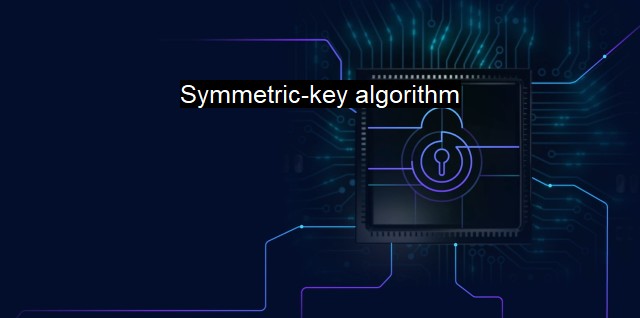What is Symmetric-key algorithm?
Securing Electronic Data Transmission with Symmetric-Key Algorithm in Cybersecurity: Understanding the Components and Importance
A symmetric-key algorithm, associated with the context of cybersecurity and antivirus methodologies, is one of the most highly influential and widely used key methods that perform critical roles in cyber securing. Unlike its counterpart that is based on an asymmetrical structure, the symmetric key algorithm uses just one secret key for both encryption and decryption operations.This particular algorithm revolves around an idea which might seem rather basic, but is staggering once unfolded. The concept constitutes using the same private key by the involved participants that should be kept a secret from everyone else. The secret key that the symmetric-key algorithms implies, enables a concept in which both the two communicating entities have a piece of shared information which is not accessible to an eavesdropper or a threat agent.
Primarily, symmetric-key algorithms are commonly divided into stream ciphers and block ciphers. Stream ciphers encrypt the bits of the message one at a time, and block ciphers take a number of bits and encrypt them as a single unit. Technically, this implies that given a block of fixed length, the block cipher would output a block of ciphertext of the same length.
Notably, symmetric-key algorithms are relatively faster compared to a public-key, or otherwise known as asymmetric algorithms. The reason behind the speed is that the symmetric cryptographic methods are ordinarily straightforward in their complexity and simplicity of design. symmetric-key algorithms demand less computational resources on server and network infrastructure, so they can frequently be more than thousands of times faster—helping to induce their widespread recognition and adoption.
In the antivirus context, symmetric-key algorithms allow us to provide secure communication or transmission of data between two entities, wherein the secure key allows the protocol to detect any intrusion or threat by an unintended third party within the communication. Such antivirus frameworks equipped with symmetric-key algorithms deeply evaluate and monitor every block of data transfer. This monitoring process helps to validate the wire's authenticity, reliability and detect if the communicated content has malware, ransomware or other cyber threats; which is unencrypted and ushers interventions to prevent mass spreading.
One primary challenge accompanying symmetric-key algorithms is key distribution. Since wherein a large network, sharing, and more importantly, storing these keys securely, with the prevention of interception by a threat agent, may not always be possible or effective. In response, cryptographers integrate symmetric key algorithms with other processes, like asymmetric, to carry out hybrid solutions for both key distribution and rapid encryption.
One must also emphasize that key security is paramount because, with the symmetric cryptographic techniques, if this single used key gets compromised, any past, present, and future messages can be decrypted by an unfavored third party. For this reason, the efficient management of such keys is essential in symmetric cryptography.
Symmetric key algorithms deliver an advantageous tool to cybersecurity specialists and antivirus technologies. These algorithms, due to their speed, simplicity, and efficiency, are fitting for framing scraping activities, encrypted conduits for data transmission, and highly secure encryption. its reliability relies predominately on the secrecy of the used key, which poses a significant risk and challenge. Hence, measures involving the highest standards of risk management, as well as back up cryptographic processes, are mandatory to ensure the effectiveness and reliability of the algorithm to face the cyber threats that entities encounter daily.

Symmetric-key algorithm FAQs
What is a symmetric-key algorithm?
A symmetric-key algorithm is a type of encryption algorithm that uses the same key to both encrypt and decrypt data. This means that both the sender and receiver of the data must have access to the secret key in order to successfully encrypt and decrypt messages.How is a symmetric-key algorithm used in cybersecurity?
Symmetric-key algorithms are commonly used in cybersecurity to protect sensitive information, such as passwords and financial transactions, from unauthorized access or interception. They are also used in antivirus software to encrypt virus definitions and signature updates to prevent them from being modified or intercepted by attackers.What are some examples of symmetric-key algorithms?
Examples of widely used symmetric-key algorithms include Advanced Encryption Standard (AES), Data Encryption Standard (DES), and Blowfish.What are the advantages and disadvantages of using a symmetric-key algorithm?
The main advantages of using a symmetric-key algorithm are speed and efficiency, as they are often faster and require less computing power than asymmetric-key algorithms. However, one major disadvantage is that the same key is used for both encryption and decryption, which means that if the key is compromised, all of the encrypted data is also compromised. Additionally, securely sharing the key with authorized parties can be a challenge, as any interception of the key could result in a breach of sensitive data.| | A | | | B | | | C | | | D | | | E | | | F | | | G | | | H | | | I | | | J | | | K | | | L | | | M | |
| | N | | | O | | | P | | | Q | | | R | | | S | | | T | | | U | | | V | | | W | | | X | | | Y | | | Z | |
| | 1 | | | 2 | | | 3 | | | 4 | | | 7 | | | 8 | | |||||||